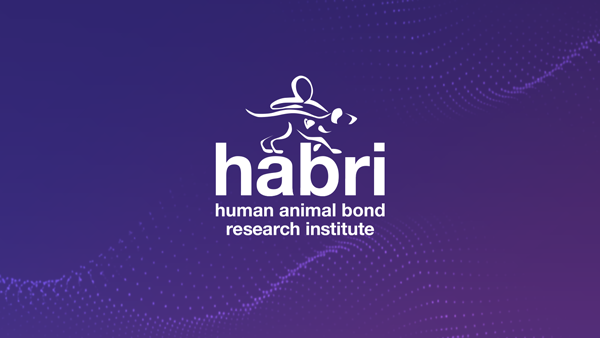While 1 in 44 children are diagnosed with autism[1], this developmental disability is still misunderstood, leading to disparities in health, education, and economic opportunity for people living with autism[2]. For this reason, more research is needed to empower all neurodiverse people to thrive and enjoy a high quality of life.
Early diagnoses of and interventions for autism are more likely to have long-term positive effects on symptoms and later skills[3]. Research strongly indicates that the human-animal bond can benefit children with autism.
Between 2016 and 2020, research on animal-assisted interventions (AAI) for people with autism has more than doubled[4]. HABRI is proud to contribute to the growing field of research investigating the benefits of companion animals for individuals with autism. The following is a summary of the HABRI-funded scientific research focused on f people living on the autism spectrum:
Animal-Assisted Social Skills Training for Children with Autism Spectrum Disorders
This study evaluated the effectiveness of an animal-assisted social skills training group for youth living with autism. It was hypothesized that incorporating dogs into social skills training (SST) would produce a greater effect on improving social skills, theory of mind, and feelings of inclusion than would be obtained from SST without an animal present.
The study recruited 31 students living with autism who were attending school at a therapeutic treatment facility. Students were assigned to either dog-assisted therapy or treatment as usual groups, which were both provided with 12 weeks of weekly treatment.
Based on student self-reports and surveys from the teachers, researchers conclude animal-assisted social skills training may be more beneficial for improving social skills and reducing related affective symptoms than traditional training models.
Long Term Effects Of Pet Dogs On Families With Children With Autism
This study assessed the long-term impact of pet dogs on families with a child with autism with a follow-up investigation to determine whether the improvements in parental stress, family normalcy and child anxiety are maintained 2.5 years after they were observed in the original study.
Families in the intervention group showed significantly reduced family difficulties over time in comparison to the control group. No significant differences were observed between the groups but stress reductions were more evident in the intervention group, with 20% of parents moving from clinically high to clinically normal stress levels. No clinically relevant reductions were observed in the control group. Additionally, significant reductions were only observed in the intervention group in the domain of parent-child dysfunctional interactions. Significant relationships were observed between parent attachment to the dog and parenting stress (perceptions of difficult child, and dysfunction parent child interactions).
Overall, the results illustrate that dog ownership is associated with enduring improvements to family functioning and may also help alleviate domains of parenting stress possibly especially if associated with parent-child dysfunctional interactions.
Physiological Wellness Effects of Animal-Assisted Activities in Children with Autism Spectrum Disorder in a Specialized Psychiatric Hospital Program
People living with autism often have a co-occurring mental health condition, such as anxiety and depression. Many of these children are treated in psychiatric hospital settings due to acute agitation involving dangerous behaviors. This study sought to investigate the effect of canine assisted activities on physiological arousal levels in children and adolescents with autism in a specialized psychiatric hospital program, with a goal of promoting mental wellness.
Overall, social-communication behaviors significantly improved in children who experienced dog-assisted activities. Specifically, participants displayed more positive emotional facial expressions, talking, use of gestures, and looking at both adults and peers.
These results suggest that animal-assisted activities with a dog may promote social-communication behaviors in psychiatrically hospitalized youth with autism spectrum disorder. Given the fact that social and communication behaviors can facilitate treatment engagement for this population, the study authors recommend future studies examine how such improvements can positively affect the psychiatric treatment of this population.
Shelter Cat Adoption in Families of Children with Autism: Impact on Children’s Social Skills and Anxiety as Well as Cat Stress
This study, funded by HABRI and the Winn Feline Foundation, explored the experiences of families that include autistic children who adopted a cat, including the effect of the introduction of a shelter cat on social skills and anxiety in children with autism, and on stress levels for the cats themselves. This wide-ranging research from the University of Missouri Research Center for Human-Animal Interaction in the College of Veterinary Medicine has resulted in four scientific papers.
The first publication, which detailed the first randomized controlled trial of cat adoption in families of children with autism, provided groundbreaking new evidence that adopted shelter cats benefit children with autism. Eleven families participated. All participating families included children with autism aged 6-14. Benefits observed include increased empathy and less separation anxiety, along with fewer problem behaviors including externalizing, bullying and hyperactivity/inattention. Additionally, children reported strong bonds to the cats.
The second publication proved the feasibility of a streamlined, standardized version of the Feline Temperament Profile (FTP) shelters can utilize to evaluate shelter cats that may be suitable for adoption into families of children with autism. The FTP is effective in evaluating the behavioral responses of cats in different situations, giving animal rescue groups another tool in their toolbox in helping cats find homes.
The third publication examined biomarkers in temperament-screened cats to assess their stress during this adoption process. Scientific analyses of fecal cortisol, weight, and behavior were measured to conclude that cats involved in the study did not experience any additional stress post-adoption.
The fourth publication explored the experiences of the parents during this adoption process. The investigators asked open-ended questions to families who participated in the study, revealing parents widely perceive their children’s social skills to benefit from the pet cat, and that the children can take responsibility for the cat without issue. Importantly, despite the added responsibilities of welcoming a cat into the family, parents themselves felt strongly bonded to their new cats and reported them as overall positive additions to the family.
Evaluating the Effects of Service Dogs on Children with Autism Spectrum Disorder (ASD) and Their Caregivers
There is a rising demand for service dogs to assist individuals with autism. Despite this demand, there is a lack of scientific evidence on how these dogs might benefit their owners. Researchers hypothesize that children with a service dog will experience many benefits, including significantly higher social and communicative skills and less frequent interfering/problem behaviors compared to children without a service dog. Importantly, this study will also evaluate the impact of the service dog on caregiver stress, hypothesizing that the addition of a service dog to the family will decrease caregiver stress, improve quality of life, and improve sleep quality as well as overall family functioning.
Learn More
To learn more about autism , including signs and symptoms, methods of diagnosing autism, and treatment and therapies, please visit the website of the National Institute of Mental Health.
[1] NIMH, Autism Spectrum Disorder nimh.nih.gov/health/statistics/autism-spectrum-disorder-asd
[2] Bishop-Fitzpatrick, L., & Kind, A. J. (2017). A scoping review of health disparities in autism spectrum disorder. Journal of Autism and Developmental Disorders, 47, 3380-3391.
[3] National Research Council, Educating Children with Autism. https://nap.nationalacademies.org/catalog/10017/educating-children-with-autism
[4] Nieforth, L. O., Schwichtenberg, A. J., & O’Haire, M. E. (2021). Animal-assisted interventions for autism spectrum disorder: a systematic review of the literature from 2016 to 2020. Review Journal of Autism and Developmental Disorders, 1-26.





